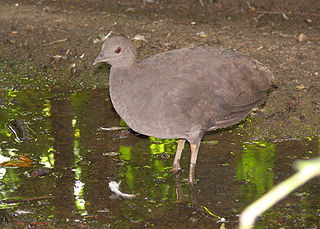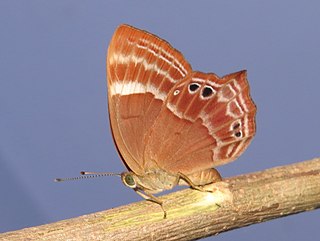Sienna is an earth pigment containing iron oxide and manganese oxide. In its natural state, it is yellowish brown and is called raw sienna. When heated, it becomes a reddish brown and is called burnt sienna. It takes its name from the city-state of Siena, where it was produced during the Renaissance. Along with ochre and umber, it was one of the first pigments to be used by humans, and is found in many cave paintings. Since the Renaissance, it has been one of the brown pigments most widely used by artists.

Umber is a natural brown or reddish-brown earth pigment that contains iron oxide and manganese oxide. Umber is darker than the other similar earth pigments, ochre and sienna.

The mottled umber is a moth of the family Geometridae. It is common throughout much of the Palearctic region. The species was first described by Carl Alexander Clerck in 1759.

Melanitis phedima, the dark evening brown, is a species of butterfly found flying at dusk. The flight of this species is erratic. They are found in south and southeast Asia.

The cinereous tinamou, also known as brushland tinamou, is a type of ground bird found in swamp and lowland forests in northern South America. They have some localized names that have been used by the indigenous people such as in Amazonas where they are called inambu-pixuna, and in Pará, Brazil where they are called nambu-sujo. Also, throughout their range they are called inhambu-preto. Cinereous tinamous have been around for many centuries. They are part of the oldest families of the world today and have fossils discovered dating back tens of millions of years. Their quick reflexes play a role in their ability to survive.
Cinereous is a colour, meaning ashy grey in appearance, either consisting of or resembling ashes, or a grey colour tinged with coppery brown. It is derived from the Latin cinereus, from cinis (ashes).
Hellinsia gratiosus is a moth of the family Pterophoridae. It is found in North America

Oidaematophorus guttatus is a moth of the family Pterophoridae. It is found in the United States.
Oidaematophorus cineraceus is a moth of the family Pterophoridae. It is found in North America.

Abisara bifasciata, the double-banded Judy or twospot plum Judy, is a butterfly in the family Riodinidae. It is found in Asia.

Lon melane, the umber skipper, is a butterfly of the family Hesperiidae. It is found in California, southern Arizona, Baja California, the highlands of Mexico and Central America. The habitat consists of desert foothills, grassy areas, streamsides, roadsides, yards, parks and open oak woodland.
Dichomeris renascens is a moth in the family Gelechiidae. It was described by Walsingham in 1911. It is found in Mexico (Tabasco).
Dichomeris eurynotus is a moth in the family Gelechiidae. It was described by Walsingham in 1897. It is found in the Central African Republic and Sierra Leone.
Onebala blandiella is a moth in the family Gelechiidae. It was described by Francis Walker in 1864. It is found in Sri Lanka, India and Myanmar.
Haplochela trigonota is a moth in the family Gelechiidae. It was described by Walsingham in 1911. It is found in Mexico, Panama, Guyana and Brazil.
Chionodes creberrima is a moth in the family Gelechiidae. It is found in Mexico (Guerrero).
Scrobipalpa parvipulex is a moth in the family Gelechiidae. It was described by Walsingham in 1911. It is found in Algeria.
Lecithocera umbripennis is a moth in the family Lecithoceridae. It was described by Charles Swinhoe in 1885. It is found in Mumbai and Pune in India.
Antaeotricha confixella is a moth in the family Depressariidae. It was described by Francis Walker in 1864. It is found in Amazonas, Brazil.

Freyeria putli, the eastern grass jewel or small grass jewel, or oriental grass jewel is a small butterfly found in Ceylon, India and Australia that belongs to the lycaenids or blues family.







